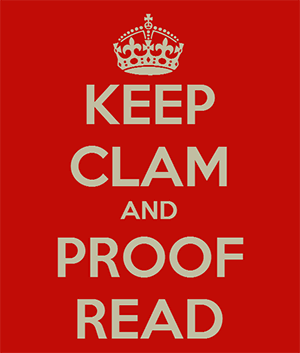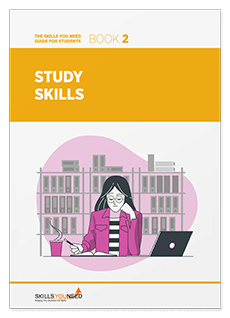Assignment Finishing Touches
See also: Learning StylesThis page – part of our Study Skills section – provides some quick advice about the things you should check before you submit an assessed assignment.
You don’t have to be a student, however, to find this page useful, perhaps you have been asked to prepare a document for work or socially?
You have, no doubt, devoted a lot of time and effort to producing your work, researching your topic, carefully constructing your arguments or findings and writing it up. (If not then see our pages: Planning an Essay and Writing an Essay or Writing a Report).
Before your work is submitted you should follow the simple framework outlined on this page to ensure that your work is received in the most positive way possible, for students this will ultimately mean better marks and for others it could mean the difference between your work being considered credible or not.
This page covers:
- Knowing Your Deadline
- Presentation Basics
- Re-reading
- Proofreading
Knowing Your Deadline
In many academic settings working to a deadline is an important skill you should develop – this also applies in work and other situations.
For some general time management advice for study see our page: Finding Time to Study.
The key thing here is knowing your deadline and making sure that you submit your work on time. In many educational establishments you will be marked down for a late submission, you may even fail, simply because you didn’t submit in time. At work missing deadlines can also have serious repercussions.
Aim to finish your main research and writing a few days before the deadline – that way you have time to work on the presentation of your work, re-read and have your work proofread.
You also need to know the procedures involved in physically submitting your work. Perhaps this is by email or by uploading to a VLE (Virtual Learning Environment) or perhaps you need to print your assignment and submit it in person – or via the mail, as may be the case for a distance-learning course. If you are submitting electronically make sure that you know what file formats are acceptable.
As a student you may be required to complete some sort of coversheet to accompany your submission. Make sure that you have one of these to hand and be prepared to sign a declaration to state that your submission is your own work.
Presentation Basics
Unless you are an art student or a graphic designer you probably don’t need to spend too long working on your presentation.
You may have been given some presentation guidelines, indicating what margins and line spacing to use, for example. If so you should carefully follow them - don't risk loosing marks because you have formatted your work poorly.
Just as personal presentation is important, especially if going for a job interview, presentation of your writing is important when submitting assignments. Good presentation creates a good first impression.
Presentation can make a big difference to the how your work is viewed and how easy it is to read, both for the marker and for you – if you refer to your work in the future.
So rather than just sending off your finished work in any old state - give some thought to its presentation.
Assignment Presentation Basics
- Use a suitable font (type-face). Generally san-serif fonts (like Arial) look best viewed on a screen and fonts with a serif (like Times New Roman) look better in print. Pick a standard font - nothing too fancy and definitely not Comic Sans - choose something which is easy to read.
- Use a sensible point size 11 or 12 are usually best. Small point sizes make the document more difficult to read and large sizes make it look as though you are trying to hide the fact that you haven't written enough!
- Include page numbers in the footer on all pages.
- Use 1½ or double line spacing.
- Use wide margins so that the marker has room for comments.
- Use bold and italics sparingly and appropriately.
- Include a title page and/or a table of contents if appropriate.
- Include your name and/or student number (or other identification) in the header or footer as appropriate.
Re-reading
For the purpose of this page, ‘re-reading’ is something you do yourself, whereas ‘proofreading’ is something you ask somebody else to do for you. The aim of both methods is the same – to check your work and eliminate errors.
You should have aimed to have finished the writing stage of your work at least a couple of days before the deadline. That way, when you re-read it, the topics are still fairly fresh in your mind but you will see what you have written with fresh eyes, making it easier to spot mistakes.
Re-read your work slowly. Your work should read smoothly, be easy to follow, and should ‘make sense’; check that you have said what you meant to say and in as clear a way as possible. It is not normally appropriate, at this stage, to make serious edits to your work although it may be appropriate to re-order sentences or paragraphs. It can help to read your work out loud – you are more likely to pick up on grammatical errors that way.
A Thesaurus can be helpful for finding other words with a similar meaning which perhaps may sound better in a particular context, or if you have overused one particular word or phrase. Remember also that although modern spell-checkers are very good, they are not fool proof. Spell-checkers have limitations and may not pick up words used in a particular context, e.g. ‘there’ and ‘their’, ‘to’ and ‘too’.
See our pages: Spelling, Punctuation, Grammar and Common Writing Mistakes for more guidance.
Make sure all your references are correct and you have included a reference list or bibliography.
See our page Academic Referencing for more.

Proofreading
If at all possible, get somebody else to read your work before you submit it.
In most cases you will not need a professional proof-reader, somebody who has decent understanding of the language is really all you require. This could be a friend or partner, or perhaps a work colleague or other student.
Your proof-reader may very well pick up fairly obvious mistakes that you have overlooked. You may, for example, often misspell particular words - you may not be aware of this but it might be obvious to another reader. Your proof-reader might also find problems with the flow of your arguments and/or grammatical issues.
Sometimes it can be difficult to accept any sort of criticism at this stage, remember, your proof-reader is doing you a favour. Listen to their comments – ultimately it will be up to you whether or not you change anything.
See our page: Dealing with Criticism if you're struggling!
Continue to:
Reflecting on Marked Work

